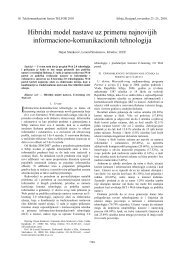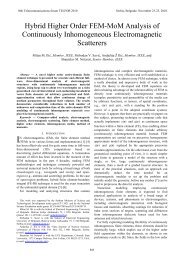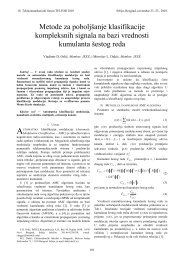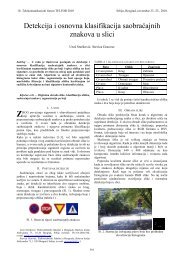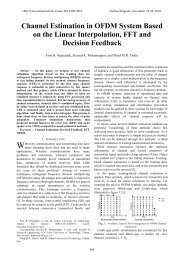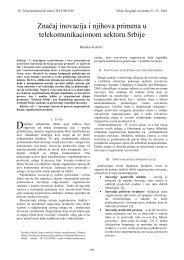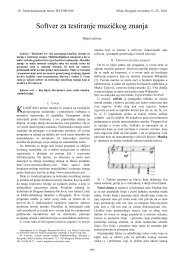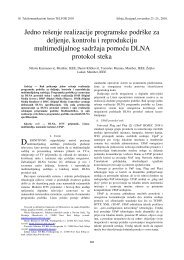Codes over Gaussian integer rings - Telfor 2010
Codes over Gaussian integer rings - Telfor 2010
Codes over Gaussian integer rings - Telfor 2010
You also want an ePaper? Increase the reach of your titles
YUMPU automatically turns print PDFs into web optimized ePapers that Google loves.
18th Telecommunications forum TELFOR <strong>2010</strong> Serbia, Belgrade, November 23-25, <strong>2010</strong>.<br />
<strong>Codes</strong> <strong>over</strong> <strong>Gaussian</strong> <strong>integer</strong> <strong>rings</strong><br />
Farhad Ghaboussi<br />
Department of Computer Science<br />
University of Applied Sciences Constance<br />
Email: farhad.ghaboussi@htwg-konstanz.de<br />
Web: www.edc.in.htwg-konstanz.de<br />
Abstract—This work presents block codes <strong>over</strong> <strong>Gaussian</strong><br />
<strong>integer</strong> <strong>rings</strong>. Rings of <strong>Gaussian</strong> <strong>integer</strong>s extend the number<br />
of possible QAM signal constellations <strong>over</strong> <strong>Gaussian</strong> <strong>integer</strong><br />
fields. Many well-known code constructions can be used for<br />
codes <strong>over</strong> <strong>Gaussian</strong> <strong>integer</strong> <strong>rings</strong>, e.g., the Plotkin construction<br />
or product codes. These codes enable low complexity soft<br />
decoding in the complex domain.<br />
Index Terms—<strong>Gaussian</strong> <strong>integer</strong>s, Plotkin construction,<br />
product codes, soft input decoding<br />
I. INTRODUCTION<br />
<strong>Gaussian</strong> <strong>integer</strong>s are a subset of the complex numbers<br />
such that the real and imaginary parts are <strong>integer</strong>s. Block<br />
codes <strong>over</strong> <strong>Gaussian</strong> <strong>integer</strong>s were first studied by Huber<br />
in [1]. Huber also introduced the Mannheim distance as<br />
a performance measure for codes <strong>over</strong> <strong>Gaussian</strong> <strong>integer</strong>s.<br />
<strong>Codes</strong> <strong>over</strong> <strong>Gaussian</strong> <strong>integer</strong>s can be used for coding <strong>over</strong><br />
two-dimensional signal spaces, e.g. using QAM signals.<br />
Similar code constructions were later considered in [2].<br />
More recently, <strong>Gaussian</strong> <strong>integer</strong>s were applied to construct<br />
space-time codes [3], [4].<br />
Most of the mentioned code constructions are linear<br />
codes based on finite <strong>Gaussian</strong> <strong>integer</strong> fields which are<br />
constructed from primes p of the form p ≡ 1mod4.The<br />
number of signal points in these complex QAM constellations<br />
is therefore limited to prime numbers satisfying<br />
this condition, e.g. p = 5, 13, 17, 29,.... Additionally,<br />
multiplicative groups were considered in [5].<br />
In this work we consider code constructions <strong>over</strong> <strong>Gaussian</strong><br />
<strong>integer</strong> <strong>rings</strong>. Such <strong>rings</strong> can be used to construct<br />
codes which are very similar to linear codes <strong>over</strong> <strong>Gaussian</strong><br />
<strong>integer</strong> fields. <strong>Gaussian</strong> <strong>integer</strong> <strong>rings</strong> can be constructed for<br />
perfect squares. They have interesting algebraic properties.<br />
We show that simple codes can be constructed similar<br />
to the one Mannheim error correcting (OMEC) codes<br />
presented by Huber in [1], by building product codes<br />
as suggested by Elias [6] or using the so-called Plotkin<br />
construction [7]. The recursive Plotkin construction can<br />
also be exploited for low-complexity decoding [8], [10].<br />
Similarly, the OMEC and product codes can be decoded<br />
using Chase-type algorithms [11].<br />
II. PRELIMINARIES<br />
<strong>Gaussian</strong> <strong>integer</strong>s are complex numbers such that the<br />
real and imaginary parts are <strong>integer</strong>s. The modulo function<br />
μ(z) of a complex number z is defined as<br />
∗ zπ<br />
μ(z) =z mod π = z −<br />
π · π∗ <br />
· π, (1)<br />
Jürgen Freudenberger<br />
Department of Computer Science<br />
University of Applied Sciences Constance, Germany<br />
Email: jfreuden@htwg-konstanz.de<br />
Web: www.edc.in.htwg-konstanz.de<br />
662<br />
where π ∗ is the conjugate of the complex number π. [·]<br />
denotes rounding to the closest <strong>Gaussian</strong> <strong>integer</strong>. That is,<br />
for a complex number z = a+ib, wehave[z] =[a]+i [b].<br />
We use the Mannheim weight and Mannheim distance as<br />
introduced in [1]. Let the Mannheim weight of the complex<br />
number z ∈Gm be defined as<br />
wtM(z) =|Re {z}|+ |Im {z}|, (2)<br />
then the Mannheim distance between two complex numbers<br />
y and z is defined as<br />
dM(y, z) =wtM(μ(z − y)) . (3)<br />
Similarly, the Mannheim weight of the vector z is<br />
wtM(z) = <br />
wtM(μ(zi)) (4)<br />
and the Mannheim distance for vectors is defined as<br />
i<br />
dM(y, z) =wtM(μ(z − y)) . (5)<br />
The Mannheim distance defines a metric.<br />
III. RINGS OF GAUSSIAN INTEGERS<br />
Most of the code constructions in [1]–[4] are linear<br />
codes based on finite <strong>Gaussian</strong> <strong>integer</strong> fields which are<br />
constructed from primes p of the form p ≡ 1mod4.For<br />
prime numbers p = 4c +1,c ∈ N the <strong>Gaussian</strong> field<br />
structure is shown in [12].<br />
We show in the following that the residue class ring<br />
of <strong>Gaussian</strong> <strong>integer</strong>s arises from the residue class ring of<br />
certain <strong>integer</strong>s with a unique quadratic decomposition.<br />
Theorem 1: Given any non-prime <strong>integer</strong> m ∈ N with a<br />
unique decomposition<br />
m = a 2 + b 2 =(a + ib)(a − ib) =Π· Π ∗ ; a, b ∈ Z<br />
there exists the residue class ring of <strong>Gaussian</strong> <strong>integer</strong>s<br />
modulo Π<br />
Gm = {0,z c 1 ,zc 2 ,...,zc m−1 }<br />
with elements<br />
z c j := zj − [ zj · Π∗ ] · Π (6)<br />
Π · Π∗ where [·] denotes rounding to the next <strong>Gaussian</strong> <strong>integer</strong>.<br />
Proof: Zm = {0, 1,...,m− 1} is a residue class<br />
ring [9]. Equation (6) is an isomorphic map, because there<br />
exist an inverse map<br />
zj =(z c j · s · Π∗ + z c∗<br />
j · t · Π) mod m, (7)<br />
where 1=s · Π ∗ + t · Π. s and t can be calculated using<br />
the Euclidean algorithm [1].
Then for all z1,z2 ∈ Zm and all z c 1,z c 2 ∈Gm we have<br />
the following ring homomorphism<br />
according to<br />
mod Π<br />
z1 + z2 mod m ↔ z c 1 + zc 2<br />
z1 · z2 mod m ↔ z c 1 · z c 2 mod Π<br />
z c 1 + z c 2 mod Π = z c 1 + z c 2 − [ (z1 + z2) · Π ∗<br />
Π · Π ∗<br />
z c 1 · z c 2 mod Π = z c 1 · z c 2 − [ (z1 · z2) · Π ∗<br />
Π · Π ∗<br />
] · Π<br />
] · Π.<br />
Example 1: For example, with n =25=4 2 +3 2 we<br />
can construct the complex residue ring G25 isomorph to the<br />
residue class ring Z25 according to 25 = (4 + 3i)(4 − 3i)<br />
G25 = {z mod (4 + 3i),z ∈ Z25}<br />
= {0, 1, 2, 3, −3i, −2+i, −1+i, i, 1 − i,<br />
2+i, −1 − 2i, −2i, 1 − 2i, −1+2i, 2i,<br />
1+2i, −2 − i, −1 − i, −i, 1 − i, 2 − i, 3i,<br />
−3, −2, −1} . (8)<br />
This complex constellation is also depicted in Fig. 1.<br />
The complex residue class ring G25 is by definition an<br />
additive group of <strong>Gaussian</strong> <strong>integer</strong>s and a monoid under<br />
multiplication. However, note that all elements of<br />
G25 \{0, 5, 10, 15, 20} = G25 \{0, (−2+i), (−1−2i), (1+<br />
2i), (2 − i)} have a multiplicative inverse. Furthermore,<br />
similar to primitive elements of a finite field there exist<br />
primitive roots that generate the ring G25 up to the<br />
elements {5, 10, 15, 20}, i.e., the powers α i of any element<br />
α ∈ {2, 3, 8, 12, 13, 17, 22, 23} generate the set<br />
G25 \{0, 5, 10, 15, 20}.<br />
Im<br />
Re<br />
Fig. 1. Complex constellation of the <strong>Gaussian</strong> <strong>integer</strong> ring G25.<br />
Theorem 1 requires an <strong>integer</strong> m with a unique decomposition,<br />
nevertheless there are non-prime <strong>integer</strong>s with<br />
multiple decompositions like 652 = a2 j + b2j = Πj ·<br />
Π∗ j ; j =1,...,4 for which one may generalize the theorem<br />
with multiple mappings to the <strong>Gaussian</strong> residue class ring<br />
corresponding to the different decompositions.<br />
IV. CODE CONSTRUCTION<br />
A code C of length n <strong>over</strong> the ring Gm is a set of<br />
codewords v = (v0,...,vn−1) with vi ∈ Gm. Wefirst<br />
define some simple codes similar to codes <strong>over</strong> finite fields.<br />
663<br />
Then we use these simple codes to construct more powerful<br />
codes based on well known code constructions. We only<br />
consider codes where the sum of two codewords is also a<br />
codeword. Hence, we have<br />
d = min<br />
v ′ ,v ′′ ∈C,v ′ =v ′′<br />
dM(v ′ , v ′′ )= min<br />
v∈C,v=0 wtM(v) (9)<br />
for the minimum Mannheim distance d of the code C.<br />
a) OMEC codes: Many code constructions presented<br />
in [1] can be applied to <strong>Gaussian</strong> <strong>integer</strong> <strong>rings</strong>. Consider<br />
for example the following one Mannheim error correcting<br />
(OMEC) code. The parity check matrix of the code of<br />
lengthupton = p(p − 1)/4 <strong>over</strong> the <strong>Gaussian</strong> residue<br />
class ring G p 2 is constructed by the elements generated by<br />
powers of a primitive root α, i.e.<br />
H =(α 0 ,α 1 ,...,α n−1 ). (10)<br />
Codewords are all vectors v =(v0,v1, ..., vn−1) with vi ∈<br />
G p 2 for which Hv T = 0. A systematic encoding for the<br />
information vector u is obtained by<br />
v = (v0,u0,...,uk−1) with (11)<br />
v0 = −α 1 u0 − α 2 u1 − ...− α n−1 uk−1.<br />
Example 2: Using the ring G25 from example 1 with<br />
p =5we can construct a code of length n =5with parity<br />
check matrix<br />
H =(1, 1+i, 2i, 1 − 2i, 3i)<br />
where we have used the primitive root α = μ(8) = 1 + i.<br />
This code has minimum Mannheim distance d =3and is<br />
able to correct any Mannheim error of weight one, because<br />
any single error from {1, −1,i,−i} will produce a different<br />
syndrome.<br />
b) Encoding binary information vectors: The mapping<br />
of a binary information vector can be done by using<br />
the Horner algorithm. We demonstrate the encoding in the<br />
following example.<br />
Example 3: The code from example 2 has dimension<br />
k = n−1 =4and therefore has mk = 390625 codewords.<br />
However, we can only map ⌊log2(mk )⌋ =18bits to each<br />
codeword which results in a rate of R = 18<br />
5 =3.6 bits per<br />
symbol.<br />
Let u (b) be the information vector in base b. Forexample,<br />
we can interpret the vector<br />
u (2) =(1, 0, 1, 1, 0, 0, 0, 0, 0, 0, 1, 0, 0, 1, 1, 0, 1, 0)<br />
as the binary representation of the <strong>integer</strong><br />
u (10) =<br />
17<br />
j=0<br />
uj2 j = 91149.<br />
Using the Horner algorithm we can find the corresponding<br />
representation in base 25<br />
u (25) =(24, 20, 20, 5).<br />
Using (6) we can map the elements of this vector to the<br />
ring G25<br />
u (4+3i) =(−1, 2 − i, 2 − i, −2+i).<br />
Finally, with (11) we obtain the codeword<br />
v =(1+i, −1, 2 − i, 2 − i, −2+i).
The encoding is systematic. Hence, using the inverse<br />
mapping in (7) we can calculate the <strong>integer</strong> representation<br />
u (10) of the information vector by 3 j=0 vj25j and the<br />
binary representation using the Horner scheme again.<br />
More powerful codes can be constructed by building<br />
product codes or using the so-called Plotkin construction.<br />
c) Product codes: The construction of product codes<br />
was suggested by Peter Elias [6]. Let C1 and C2 be<br />
(n1,k1,d1) and (n2,k2,d2) group codes <strong>over</strong> the <strong>Gaussian</strong><br />
<strong>integer</strong> ring Gm, respectively. We first encode k2 codewords<br />
of the code C1 and store these codewords column wise into<br />
the first k2 columns of a (n1 × n2)-matrix. Then we use<br />
the code C2 n1-times to encode each row of this matrix.<br />
The resulting code C has length n = n1n2 and dimension<br />
k = k1k2.<br />
Theorem 2: A product code <strong>over</strong> a <strong>Gaussian</strong> <strong>integer</strong> ring<br />
has minimum Mannheim distance d ≥ d1d2.<br />
Proof: According to (9) the minimum Mannheim<br />
distance of the product code is equivalent to the minimum<br />
weight of a non-zero codeword. A non-zero codeword has<br />
at least one non-zero column. This column is a codeword<br />
of the code C1 and has at least weight d1. However, each<br />
non-zero element of this column results in a non-zero row.<br />
Each non-zero row is a codeword of the code C2 and has<br />
at least weight d2. Hence, a non-zero codeword has at least<br />
d1 non-zero rows each with minimum weight d2.<br />
Example 4: We can use the code from example 2 to<br />
construct a product code of length n =25,dimensionk =<br />
16, and minimum Mannheim distance d =9. This code<br />
has rate R = 75<br />
25 =2.96 bits per symbol.<br />
d) Plotkin construction: Given two codes of length<br />
n, the Plotkin construction can be used to obtain a code of<br />
length 2n [7]. This construction works for linear and nonlinear<br />
codes. Let C1 and C2 be two block codes of length<br />
n1 = n2 <strong>over</strong> the <strong>Gaussian</strong> <strong>integer</strong> ring Gm. We construct<br />
a code C by direct vector addition<br />
C = {|v ′ |v ′ + v ′′ |, v ′ ∈C1, v ′′ ∈C2} (12)<br />
Then C is also a block code <strong>over</strong> Gm. C has length n =2n1<br />
and dimension k = k1 + k2, wherek1and k2 are the<br />
dimensions of the codes C1 and C2, respectively.<br />
Theorem 3: Code C resulting from the Plotkin construction<br />
has minimum Mannheim distance d ≥ min{2d1,d2},<br />
where d1 and d2 are the distances of the codes C1 and C2,<br />
respectively.<br />
The proof is very similar to the proof of the Plotkin<br />
construction for binary codes in [12].<br />
Example 5: We can use the code from example 2 as<br />
code C1 and a repetition code C2 of length n2 = n1 =<br />
5 to construct a Plotkin code of length n =2n1 =10.<br />
A repetition code of length n2 is obtained by repeating<br />
the information symbol u ∈Gm n2-times. The code has<br />
dimension k2 =1and minimum Mannheim distance d2 =<br />
n2. The resulting Plotkin code has dimension k =5and<br />
minimum Mannheim distance d =5. Thus, this code has<br />
rate R = 23<br />
10 =2.3 bits per symbol.<br />
V. DECODING<br />
Let r = v + e denote the received vector where e is the<br />
error vector. We first consider hard input decoding, i.e.,<br />
we assume that ei ∈Gm. Reference [1] presents a simple<br />
664<br />
algebraic decoding algorithm for the code from example 2.<br />
This code can correct any single error of Mannheim weight<br />
one. For the algebraic decoding we calculate the syndrome<br />
s = Hr T . We obtain the error location as l =log α smodn<br />
and the error value el = Sα −l .<br />
a) Hard input decoding of Plotkin codes: Now consider<br />
the code resulting from the Plotkin construction as<br />
in example 5. The code has minimum Mannheim distance<br />
d =5and can correct any error up to Mannheim weight<br />
two using the following decoding procedure. We assume<br />
that the received vector is<br />
r = |r ′ |r ′′ | = v + e<br />
with e = |e ′ |e ′′ |, i.e., r ′ and e ′ denote the first halves of<br />
the received vector and the error vector, r ′′ and e ′′ denote<br />
the second halves, respectively.<br />
Let t be the Mannheim weight of e. First,wedecodethe<br />
vector r ′′ − r ′ = v ′′ + e ′′ − e ′ with respect to the repetition<br />
code C2 using majority logic decoding, i.e., selecting the<br />
symbol with the largest number of occurrences. Note that<br />
the vector e ′′ − e ′ has Mannheim weight less or equal t.<br />
Hence, C2 corrects all errors with t ≤⌊ d<br />
2 ⌋.Letˆv′′ denote<br />
the resulting estimate.<br />
In the second step, we decode r ′ and r ′′ − ˆv ′′ with<br />
respect to C1 which results in two estimates ˆv ′<br />
1<br />
and ˆv′<br />
2 ,<br />
respectively. Note that either e ′ or e ′′ has Mannheim weight<br />
less or equal t/2. Therefore, either ˆv ′<br />
1 or ˆv′ 2 is equal to the<br />
transmitted codeword v ′ ∈C1 if t ≤⌊ d<br />
2 ⌋.<br />
To obtain the final estimate ˆv, we construct the code-<br />
words |ˆv ′<br />
1 |ˆv′<br />
1 + ˆv′′ |, |ˆv ′<br />
2 |ˆv′<br />
2 + ˆv′′ | and select the one which<br />
is closest to the received vector r.<br />
b) Chase-type decoding: Chase algorithms [11] are<br />
sub-optimum decoding algorithms for linear binary block<br />
codes. This class of algorithms provides an efficient tradeoff<br />
between error performance and decoding complexity.<br />
They are based on conventional algebraic decoders. Where<br />
the decoder generates a set of candidate codewords by<br />
flipping some bit positions (test patterns) previous to the<br />
algebraic decoding. The most likely codeword in this list<br />
is chosen as the final estimate.<br />
In the following we discuss low-complexity soft input<br />
decoding procedures. In particular we show that the Chase<br />
approach can be applied to codes <strong>over</strong> <strong>Gaussian</strong> <strong>integer</strong>s.<br />
Although the Chase-type algorithms are rather old, such<br />
decoders are still highly relevant (see e.g. [13]).<br />
Let r =(r0,...,rn−1) be the received vector after transmission<br />
<strong>over</strong> an additive white <strong>Gaussian</strong> noise (AWGN)<br />
channel. ˆri =[ri] denotes the hard-decision for the i-th<br />
symbol, where [·] denotes rounding to the closest <strong>Gaussian</strong><br />
<strong>integer</strong>.<br />
A Chase decoder generates a list of possible codewords,<br />
which is used to calculate the estimated codeword by<br />
comparing each codeword in the list with the received<br />
vector r. In the case of binary codes, the list of codewords<br />
is obtained by flipping bits in certain positions of the<br />
received sequence. In the case of codes <strong>over</strong> <strong>Gaussian</strong><br />
<strong>integer</strong>s, we add the symbols {1, −1,i,−i} to the most<br />
unreliable symbol positions, i.e., to the positions with<br />
largest weight wtM(ˆri − ri).<br />
Simulation results for the code from example 2 are<br />
depicted in Fig. 2. With hard input decoding the simple
OMEC code achieves a gain of approximately 2.5dB for a<br />
symbol error rate of 10 −4 . Soft input decoding obtains an<br />
additional gain of 0.5dB with a list of 13 codewords.<br />
error rate<br />
10 0<br />
10 −1<br />
10 −2<br />
10 −3<br />
10 −4<br />
uncoded<br />
hard<br />
soft<br />
12 13 14 15 16 17<br />
E /N [dB]<br />
S 0<br />
18 19 20 21 22<br />
Fig. 2. Simulation results for the OMEC code from example 2 <strong>over</strong> G25<br />
for the AWGN channel.<br />
This concept of soft decoding can also be applied to<br />
Plotkin codes. Consider the hard input decoding described<br />
in the previous paragraph. A simple soft input decoder<br />
is obtained if, in the final decoding step, the closest<br />
codeword is determined by using the Euclidean distance.<br />
Corresponding simulation results for the code from example<br />
5 are depicted in Fig. 3. In this case, hard input<br />
decoding achieves a gain close to 4dB for a symbol error<br />
rate of 10 −4 . With this simple soft input decoding we<br />
obtain an additional gain of 0.5dB with only two candidate<br />
codewords.<br />
A larger list can be obtained by using list decoding for<br />
the constituent codes. In the first decoding step, we can<br />
use soft input maximum-likelihood decoding to decode the<br />
repetition code and obtain a list L2 of codewords from code<br />
C2 by adding the symbols {1, −1,i,−i} to the maximumlikelihood<br />
estimate. In the second step, we use Chase<br />
decoding for r ′ . Furthermore, we use Chase decoding for<br />
r ′′ − ˆv ′′<br />
l<br />
for each element ˆv′′<br />
l ∈L2 of the list. This results<br />
in a list L1 of codewords from the code C1.<br />
Finally, we construct all possible codewords<br />
|ˆv ′ j|ˆv ′ j + ˆv ′′<br />
l |, ˆv ′ j ∈L1, ˆv ′′<br />
l ∈L2<br />
and select the one which is closest to the received vector.<br />
VI. CONCLUSIONS<br />
In this work we have considered codes <strong>over</strong> <strong>Gaussian</strong><br />
<strong>integer</strong> <strong>rings</strong>. All constructions are possible for <strong>Gaussian</strong><br />
<strong>integer</strong> fields as well as for <strong>rings</strong>. <strong>Gaussian</strong> <strong>integer</strong> <strong>rings</strong><br />
extend the possible complex signal constellations for codes<br />
<strong>over</strong> <strong>Gaussian</strong> <strong>integer</strong>s. We have shown that binary information<br />
vectors can easily be encoded to such codes.<br />
Most previous publications on codes <strong>over</strong> <strong>Gaussian</strong><br />
<strong>integer</strong>s considered only hard input or optimum maximumlikelihood<br />
decoding (e.g. [1]-[5]). However, maximumlikelihood<br />
decoding is only feasible for small signal constellations<br />
and short codes. We have shown that lowcomplexity<br />
soft input decoding is possible by using a<br />
665<br />
error rate<br />
10 0<br />
10 −1<br />
10 −2<br />
10 −3<br />
10 −4<br />
uncoded<br />
hard<br />
soft<br />
12 13 14 15 16 17<br />
E /N [dB]<br />
S 0<br />
18 19 20 21 22<br />
Fig. 3. Simulation results for the Plotkin code from example 5 <strong>over</strong> G25<br />
for the AWGN channel.<br />
Chase-type algorithm [11]. Likewise, the recursive structure<br />
of the Plotkin construction can be exploited for<br />
decoding similar to the sub-optimum decoding of Reed-<br />
Muller codes [8], [10], [14].<br />
REFERENCES<br />
[1] K. Huber, <strong>Codes</strong> <strong>over</strong> <strong>Gaussian</strong> <strong>integer</strong>s, Information Theory, IEEE<br />
Transactions on, Volume 40, Issue 1, Jan. 1994 Page(s):207 - 216<br />
Information Theory, IEEE Transactions on, Volume: 41 , Issue 5,<br />
1995 , Page(s): 1512 - 1517<br />
[2] Xue-dong Dong, Cheong Boon Soh, E. Gunawan, Li-zhong Tang,<br />
Groups of algebraic <strong>integer</strong>s used for coding QAM signals, Information<br />
Theory, IEEE Transactions on, Volume 44, Issue 5, Sept.<br />
1998 Page(s):1848 1860<br />
[3] M. Bossert, E.M. Gabidulin, P. Lusina, Space-time codes based on<br />
<strong>Gaussian</strong> <strong>integer</strong>s, inInformation Theory, 2002. Proceedings. 2002<br />
IEEE International Symposium on, 2002 Page(s):273 - 421<br />
[4] P. Lusina, S. Shavgulidze, M. Bossert, Space - time block factorisation<br />
codes <strong>over</strong> <strong>Gaussian</strong> <strong>integer</strong>s, IEE Proceedings, Volume 151,<br />
Issue 5, 24 Oct. 2004 Page(s):415 - 421<br />
[5] J. Rifa, Groups of complex <strong>integer</strong>s used as QAM signals,<br />
[6] P. Elias, Error-free coding, IRE Trans. on Inform. Theory, PGIT-4:<br />
29-37, 1954.<br />
[7] Morris Plotkin, Binary <strong>Codes</strong> with Specified Minimum Distance,<br />
IRE Transactions on Inform. Theory, Vol. 6, pp. 445-450, 1960<br />
[8] G. Schnabl, M. Bossert, Soft-Decision Decoding of Reed-Muller<br />
<strong>Codes</strong> as Generalized Multiple Concatenated <strong>Codes</strong>, Information<br />
Theory, IEEE Transactions on, Vol. IT-41, pp. 304-308, 1995<br />
[9] H. Scheid and A. Frommer, ”Number theory”, (German), (Elsevier-<br />
Spektrum Akademiv publishing, 2007).<br />
[10] N. Stolte, Rekursive <strong>Codes</strong> mit der Plotkin-Konstruktion und ihre<br />
Decodierung, [Dissertation], TU Darmstadt, 2002<br />
[11] D. Chase, A class of algorithms for decoding block codes with<br />
channel measurement information, IEEE Trans. Inform. Theory,<br />
Vol. 18, pp. 170- 182, Jan. 1972.<br />
[12] M. Bossert, Channel Coding for Telecommunications, John Wiley<br />
& Sons, 1999<br />
[13] C. Argon, S.W. McLaughlin, and T. Souvignier, Iterative application<br />
of the Chase algorithm on Reed-Solomon product codes, Proceedings<br />
IEEE ICC 2001, pp. 320-324, 2001.<br />
[14] I. Dumer , G. Kabatiansky, C. Tavernier, List decoding of Reed-<br />
Muller codes up to the Johnson bound with almost linear complexity,<br />
Proceedings Information Theory, 2006 IEEE International<br />
Symposium on , pp.138-142, 9-14 July 2006



